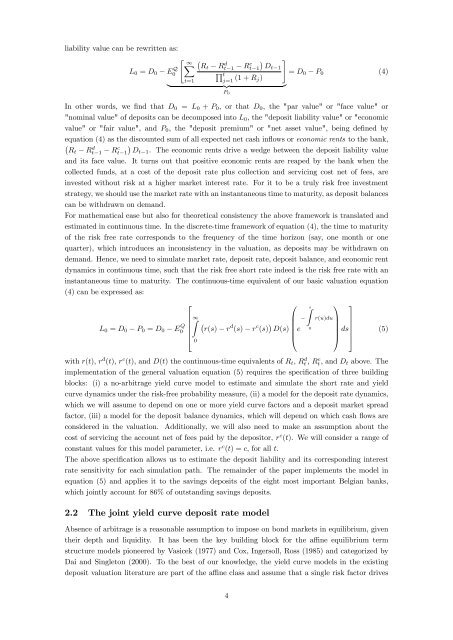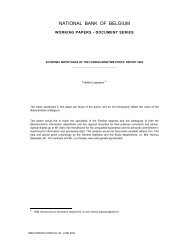A multi-factor model for the valuation and risk management of ...
A multi-factor model for the valuation and risk management of ...
A multi-factor model for the valuation and risk management of ...
You also want an ePaper? Increase the reach of your titles
YUMPU automatically turns print PDFs into web optimized ePapers that Google loves.
liability value can be rewritten as:<br />
" 1<br />
#<br />
X<br />
L 0 = D 0 E0<br />
Q R t Rt d 1 Rt 1 c Dt 1<br />
Q t<br />
t=1<br />
j=1 (1 + R = D 0 P 0 (4)<br />
j)<br />
| {z }<br />
P 0<br />
In o<strong>the</strong>r words, we …nd that D 0 = L 0 + P 0 , or that D 0 , <strong>the</strong> "par value" or "face value" or<br />
"nominal value" <strong>of</strong> deposits can be decomposed into L 0 , <strong>the</strong> "deposit liability value" or "economic<br />
value" or "fair value", <strong>and</strong> P 0 , <strong>the</strong> "deposit premium" or "net asset value", being de…ned by<br />
equation (4) as <strong>the</strong> discounted sum <strong>of</strong> all expected net cash in‡ows or economic rents to <strong>the</strong> bank,<br />
R t Rt d 1 Rt 1 c Dt 1 . The economic rents drive a wedge between <strong>the</strong> deposit liability value<br />
<strong>and</strong> its face value. It turns out that positive economic rents are reaped by <strong>the</strong> bank when <strong>the</strong><br />
collected funds, at a cost <strong>of</strong> <strong>the</strong> deposit rate plus collection <strong>and</strong> servicing cost net <strong>of</strong> fees, are<br />
invested without <strong>risk</strong> at a higher market interest rate. For it to be a truly <strong>risk</strong> free investment<br />
strategy, we should use <strong>the</strong> market rate with an instantaneous time to maturity, as deposit balances<br />
can be withdrawn on dem<strong>and</strong>.<br />
For ma<strong>the</strong>matical ease but also <strong>for</strong> <strong>the</strong>oretical consistency <strong>the</strong> above framework is translated <strong>and</strong><br />
estimated in continuous time. In <strong>the</strong> discrete-time framework <strong>of</strong> equation (4), <strong>the</strong> time to maturity<br />
<strong>of</strong> <strong>the</strong> <strong>risk</strong> free rate corresponds to <strong>the</strong> frequency <strong>of</strong> <strong>the</strong> time horizon (say, one month or one<br />
quarter), which introduces an inconsistency in <strong>the</strong> <strong>valuation</strong>, as deposits may be withdrawn on<br />
dem<strong>and</strong>. Hence, we need to simulate market rate, deposit rate, deposit balance, <strong>and</strong> economic rent<br />
dynamics in continuous time, such that <strong>the</strong> <strong>risk</strong> free short rate indeed is <strong>the</strong> <strong>risk</strong> free rate with an<br />
instantaneous time to maturity. The continuous-time equivalent <strong>of</strong> our basic <strong>valuation</strong> equation<br />
(4) can be expressed as:<br />
L 0 = D 0 P 0 = D 0 E Q 0<br />
2<br />
1Z<br />
6<br />
4<br />
0<br />
0<br />
r(s) r d (s) r c (s) D(s)<br />
B<br />
@ e<br />
Z s<br />
0<br />
r(u)du<br />
1 3<br />
C<br />
A ds 7<br />
5<br />
(5)<br />
with r(t), r d (t), r c (t), <strong>and</strong> D(t) <strong>the</strong> continuous-time equivalents <strong>of</strong> R t , Rt d , Rt, c <strong>and</strong> D t above. The<br />
implementation <strong>of</strong> <strong>the</strong> general <strong>valuation</strong> equation (5) requires <strong>the</strong> speci…cation <strong>of</strong> three building<br />
blocks: (i) a no-arbitrage yield curve <strong>model</strong> to estimate <strong>and</strong> simulate <strong>the</strong> short rate <strong>and</strong> yield<br />
curve dynamics under <strong>the</strong> <strong>risk</strong>-free probability measure, (ii) a <strong>model</strong> <strong>for</strong> <strong>the</strong> deposit rate dynamics,<br />
which we will assume to depend on one or more yield curve <strong>factor</strong>s <strong>and</strong> a deposit market spread<br />
<strong>factor</strong>, (iii) a <strong>model</strong> <strong>for</strong> <strong>the</strong> deposit balance dynamics, which will depend on which cash ‡ows are<br />
considered in <strong>the</strong> <strong>valuation</strong>. Additionally, we will also need to make an assumption about <strong>the</strong><br />
cost <strong>of</strong> servicing <strong>the</strong> account net <strong>of</strong> fees paid by <strong>the</strong> depositor, r c (t). We will consider a range <strong>of</strong><br />
constant values <strong>for</strong> this <strong>model</strong> parameter, i.e. r c (t) = c, <strong>for</strong> all t.<br />
The above speci…cation allows us to estimate <strong>the</strong> deposit liability <strong>and</strong> its corresponding interest<br />
rate sensitivity <strong>for</strong> each simulation path. The remainder <strong>of</strong> <strong>the</strong> paper implements <strong>the</strong> <strong>model</strong> in<br />
equation (5) <strong>and</strong> applies it to <strong>the</strong> savings deposits <strong>of</strong> <strong>the</strong> eight most important Belgian banks,<br />
which jointly account <strong>for</strong> 86% <strong>of</strong> outst<strong>and</strong>ing savings deposits.<br />
2.2 The joint yield curve deposit rate <strong>model</strong><br />
Absence <strong>of</strong> arbitrage is a reasonable assumption to impose on bond markets in equilibrium, given<br />
<strong>the</strong>ir depth <strong>and</strong> liquidity. It has been <strong>the</strong> key building block <strong>for</strong> <strong>the</strong> a¢ ne equilibrium term<br />
structure <strong>model</strong>s pioneered by Vasicek (1977) <strong>and</strong> Cox, Ingersoll, Ross (1985) <strong>and</strong> categorized by<br />
Dai <strong>and</strong> Singleton (2000). To <strong>the</strong> best <strong>of</strong> our knowledge, <strong>the</strong> yield curve <strong>model</strong>s in <strong>the</strong> existing<br />
deposit <strong>valuation</strong> literature are part <strong>of</strong> <strong>the</strong> a¢ ne class <strong>and</strong> assume that a single <strong>risk</strong> <strong>factor</strong> drives<br />
4
















